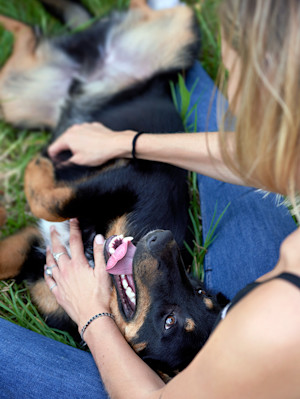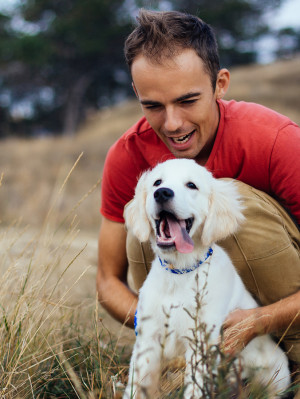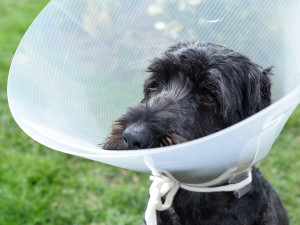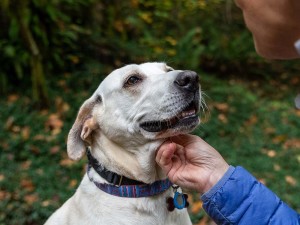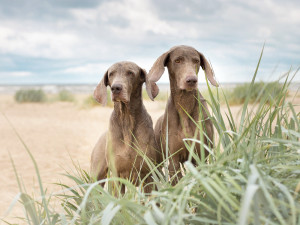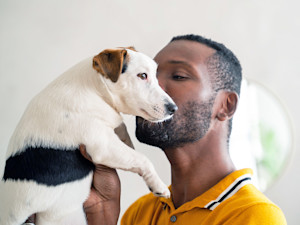Do Dogs Go Through Menopause?
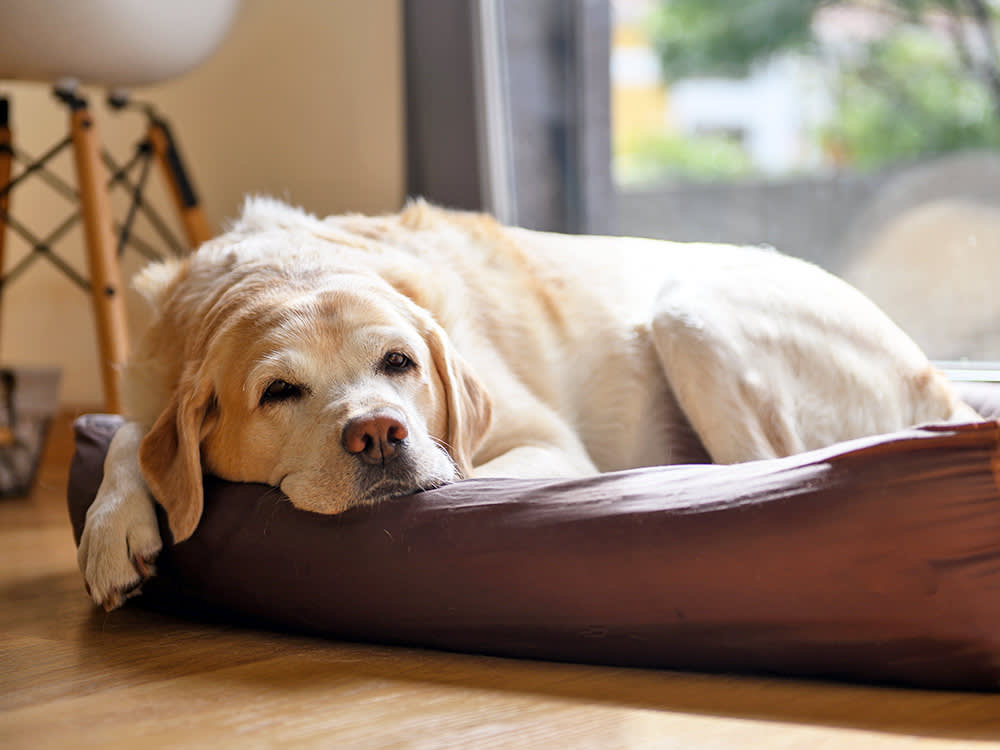
Share Article
In This Article:
Canine Reproductive Cycle Explained How Spaying Impacts a Dog’s Reproductive Cycle At What Age Do Changes in the Reproductive Cycle Occur in Dogs? Signs of Reproductive Aging in Dogs Does a Dog’s Quality of Life Change after Reproductive Aging? Frequently Asked Questions
Just in case anyone needs a primer: What is menopause? In humans, it is the change from ovulation and menstruation to the hormonally driven end of both. Dogs who are spayed no longer have ovaries, so they obviously do not ovulate or experience menstruation. However, intact dogs have cycles similar to those of women, but canines do not have an absolute end to these cycles.
They do not go through menopause. Dogs can cycle to the end of their lives, though they may become irregular and have decreased fertility. However, an important point to remember is that a dog can become pregnant, even in their senior years.

Canine reproductive cycle explained
Dogs have an estrous cycle with four phases:
Proestrus lasts from seven to 10 days and is characterized by vulvar swelling and bloody discharge. Female dogs are not ready to mate, but the males are interested due to the rise in estrogen of the female.
Estrus, also referred to as “standing heat,” lasts from five to 10 days. The discharge will be lighter, progesterone will begin to rise, and a hormone called luteinizing hormone (LH) will cause ovulation to occur. This is when pregnancy can begin.
Diestrus: Progesterone dominates, regardless of whether the dog is pregnant, for around 60 days. It accounts for the various changes in the body. At the end of diestrus, the dog either gives birth or continues for a few days with signs of a false pregnancy (nesting, lactation). Behavior returns to baseline, and discharge stops.
Anestrus lasts two to eight months and is the quiet period during which the ovaries, uterus, and hormones are inactive.
Most dogs experience about two cycles per year, but one to three can still be normal. Unlike humans, dogs don’t menstruate monthly; their “period” is the proestrus/estrus discharge that appears approximately twice a year, with considerable individual and breed variation.
How spaying impacts a dog’s reproductive cycle
Spaying (ovariohysterectomy or ovariectomy) is the removal of the ovaries and, most often, also the uterus. Without these organs, estrogen and progesterone cannot be produced. This surgery permanently stops heat cycles.
There are some key points to remember about spaying:
There will no longer be heat cycles or the ability to conceive.
Health benefits: Without a uterus, a dog is no longer at risk of developing pyometra, a uterine infection. Likewise, ovarian cancer or other conditions of the ovaries are no longer a concern. Spaying before the first or second heat significantly reduces the lifetime risk of mammary tumors.
Ovarian remnant syndrome (rare): If a piece of ovarian tissue remains in the body after surgery, a dog may exhibit signs of being in heat after the spay. This typically requires veterinary evaluation and surgical correction.
Behavior and metabolism: Some spayed dogs may show an improvement in temperament. Some individuals may gain weight and require adjustments in the amount of calories they consume and/or the level of exercise they engage in.
The health benefits alone make most pet parents lean toward spaying their pets.
At what age do changes in the reproductive cycle occur in dogs?
Age affects several factors: onset, frequency, and fertility.
Puberty: Small breeds may begin having cycles as early as six months, while large/giant breeds are more likely to start between nine and 18 months.
Prime fertility: It varies, but typically occurs from the second or third heat through four to six years of age, during which dogs are at their most fertile. This depends on individual health and breed.
Middle age to senior: This is when cycles become more erratic, inter-estrus intervals become longer, litter sizes shrink, and heats become silent.
Remember: there is no universal “stop date.” An intact 11-year-old may still cycle — and can become pregnant — though fertility declines and whelping risks rise with age.
Signs of reproductive aging in dogs
You may notice:
Longer gaps between heats, skipped cycles, or split heats.
Very little discharge or swelling despite hormonal cycling — easy to miss in heavily groomed dogs.
Lower conception rates, smaller litters, and higher early embryonic loss.
Increased occurrence of false pregnancy during diestrus, mammary gland development, and temporary behavioral shifts.
Most importantly, health risks that rise with age if left intact:
Pyometra: Usually happens two to eight weeks after heat; signs include lethargy, fever, increased thirst/urination, abdominal discomfort, and vaginal discharge (which may be absent in “closed” pyometra). This is an emergency. It is life-threatening.
Mammary tumors: The risk increases with each heat.
Uterine/ovarian cysts or cancer: Less common than mammary tumors but possible.
Does a dog’s quality of life change after reproductive aging?
If you could ask dogs, they would probably say that their cycles are just a nuisance and they care much more about overall health, mobility, play, food, and love. They do not need to have heat cycles or give birth to have a good quality of life.
Keep these points in mind:
Intact seniors: Heat cycles can be inconvenient (discharge, attention from male dogs) and carry a higher pyometra risk
Spayed dogs: Typically experience stable behavior and no heat-related management issues. Weight needs to be overseen.
Breeding seniors: Breeding older dogs requires pre-breeding exams, progesterone timing, and frank discussion of maternal/fetal risks. You won’t find many veterinarians who are comfortable with first-time breeding at older ages.
Bottom line
So, we’ve found the answer and a few additional tips that go beyond it. Dogs do not go through natural menopause. Intact females continue to cycle throughout their lives, although their cycles can be erratic, and they are less fertile. However, they can still get pregnant.
Spaying a dog can prevent serious diseases. Breeding a senior dog is generally not recommended. Consult with your veterinarian.
FAQs
Do all female dogs stop having heat cycles?
No. It’s just the opposite. Most female dogs continue to cycle throughout their lives. With age, cycles may become irregular or less obvious, but a complete natural stop is uncommon. Always assume an intact female can still cycle and become pregnant unless proven otherwise.
Can dogs get pregnant at any age?
Yes — if they are intact and cycling. However, fertility decreases with age, and the risks of pregnancy, whelping complications, and neonatal loss increase. Veterinarians discourage breeding senior dogs unless their veterinarian evaluates them and there’s a strong medical rationale for doing so.
Do dogs go through menopause after being spayed?
Dogs, in general, do not go through menopause, and even if they did, they wouldn’t after being spayed.
References
Concannon, Patrick W. “Reproductive Cycles of the Domestic Bitch.”opens in new tab Animal Reproduction Science, vol. 124, no. 3-4, Apr. 2011, pp. 200–210, https://doi.org/10.1016/j.anireprosci.2010.08.028.
“The Bitch‘s Heat Cycle: A Dog Lover‘s Guide to Proestrus and Estrus Behavior | 33rd Square.” opens in new tab33rdsquare.com, 23 Jan. 2024, Accessed 6 Oct. 2025.
Ottka, Claudia, et al. The Metabolic Differences of Anestrus, Heat, Pregnancy, Pseudopregnancy, and Lactation in 800 Female Dogsopens in new tab. Vol. 10, 2 Feb. 2023, www.ncbi.nlm.nih.gov/pmc/articles/PMC9932911/.
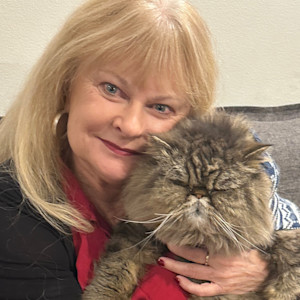
Dr. Shelby Neely, DVM
Dr. Shelby Neely is a freelance writer and veterinarian who graduated from the University of Pennsylvania School of Veterinary Medicine and has practiced veterinary medicine for 30 years, specializing in small animals. Her work has appeared in Allivet, AsktheCatDoctor, WhiskerDocs, Ask the Cat Doctor Radio, Ask the Cat Doctor TV, and numerous other websites, brochures, newsletters, newspapers, and ebooks. In her spare time, Dr. Neely likes to spend time with her three children, two grandchildren, three cats, two grand-cats, and five grand-dogs.
Related articles
![black scruffy dog wearing cone recovering from spay surgery]()
Everything You Need to Know About Spaying and Neutering Your Dog
A vet’s take on why it’s a smart choice. Snip, snip!
Is Your Female Dog Humping? Here’s Why It’s Actually Normal
Take these steps to respond to the problem.
![Closeup of white lab mix dog being pet under the chin by pet parent]()
Can Dogs Get Breast Cancer?
Sadly, yes — one in four dogs will develop mammary tumors — but there's an easy way to prevent them.
Male vs. Female Dogs: Are There Any Real Differences?
World-renowned behaviorist Patricia McConnell explains.
How Can You Tell if Your Dog Is in Heat?
![Man holding his dog at home.]()
Dogs in Heat: Signs, Stages, and Care Tips
Helpful tips to keep your dog safe and comfortable.
